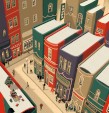In 2004, painter Sandow Birk began a series of works that involved transcribing the Qur’an into English. Birk’s plan was to get a better, more personal understanding of Islam, a religion that is often poorly understood in the U.S. and yet central to critical events taking place around the world. Completed in 2013, the result of his nine-year immersion into Islamic tradition is American Qur’an, a series of 114 paintings linked to every sura (chapter) of the Qur’an. The oversized hardcover book is set to be released in November from Liveright Publishing. It is also one of PW’s Best Books of 2015.
A painter noted for his tongue-in-cheek tributes to Goya and other classic painters, Birk is known for producing lavish, ironic re-creations of epic works, such as In Smog and Thunder: The Great War of the Californias, a project involving more than 100 paintings, drawings, and other artwork from 2000 and depicting an imaginary war between San Francisco and L.A.
However, unlike Birk’s other works, American Qur’an presented a far greater potential for provocation, controversy, and possibly public protest. Birk is not Muslim, and there were fears—both from Birk’s gallery and later his publisher—that the project might be seen as offensive rather than as a tribute.
But in a tribute to Birk’s commitment to researching and adhering to Islamic visual traditions—such as no depictions of Muhammad, no denigration or consecration of figures, a focus on the message of the Qur’an, etc.—the project has mostly been embraced from the beginning. The book project includes essays in support of the project from a number of religion academics—among them, Reza Aslan, author of the bestselling Zealot: The Life and Times of Jesus of Nazareth.
Liveright editor Phil Marino said the idea to produce a book documenting Birk’s paintings came from Peter Simon in the Norton college division, who saw coverage of Birk’s art project in the New York Times and brought it to the attention of the trade division. Marino said, “We loved it,” and he immediately called Birk’s representatives at the Catherine Clark Gallery in California to create a book.
Marino conceded that there were concerns about the book at Liveright after the attacks at Charlie Hebdo in Paris earlier this year. But Marino also emphasized that “Sandow’s respect for Islam and the Muslim community shines through on every page.”
The 464-page $100 hardcover has a 10,000-copy initial printing. Publicity and promotion, Marino said, will focus on “getting people to understand how unique this project is: the merging of Muslim and American culture.”
Birk researched the history of the Qur’an and found a long Islamic tradition devoted to using beautifully rendered calligraphy to re-create the book’s Arabic text. Birk has done the same, transcribing the 114 chapters of the Qur’an in a quirky, graffiti-influenced script. He placed his calligraphic transcription of the Qur’an’s text over a visual survey of contemporary American life—images from small-town and urban life.
American Qur’an is an illuminated manuscript for the present day, invoking the presence of Islam throughout American life. With its richly designed sacred script and partially obscured genre scenes, the paintings in American Qur’an manage to be engaging and visually eccentric while also being reassuring about its subject matter.
Birk emphasized that the paintings in American Qur’an are not intended to be a literal illustration of the Arabic text. But he also acknowledged that the text transcription of each sura is “linked” to the images with which they are paired. He described the images as metaphors, saying, “It’s diffuse, but there’s always a connection between the images and text.”
Birk said the nine-year project began “out of personal curiosity to learn more about the Qur’an. As it grew I hoped it would reach a broader American audience—people like me who would be able to learn more about Islam.”








